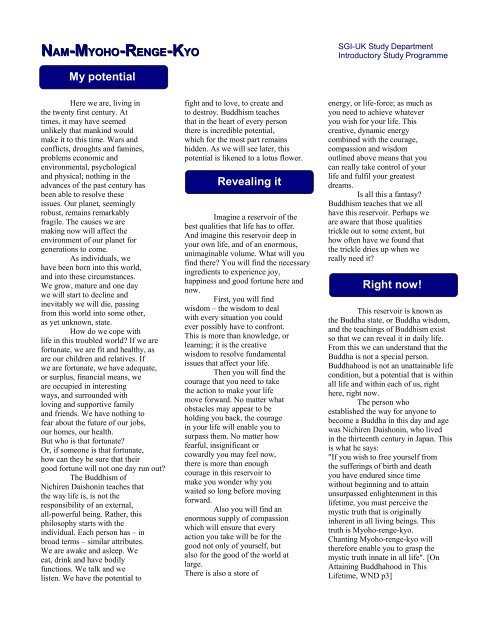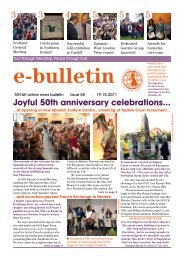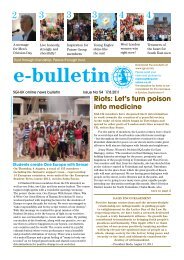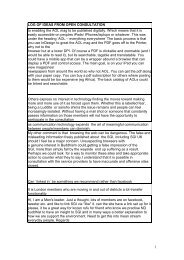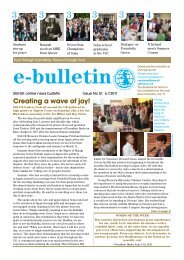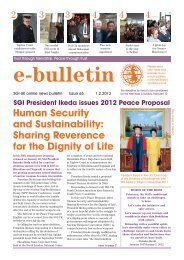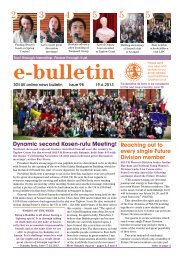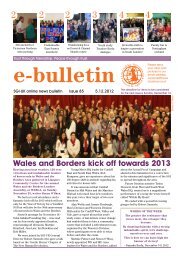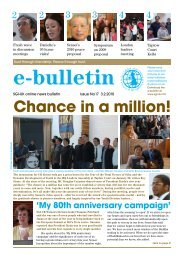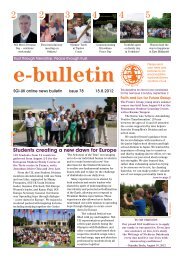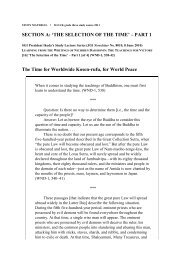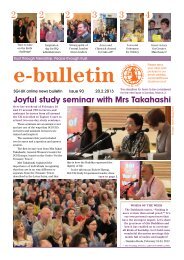Create successful ePaper yourself
Turn your PDF publications into a flip-book with our unique Google optimized e-Paper software.
AM-M<br />
NAM-MYOHO-RENGE-KYO<br />
SGI-UK Study Department<br />
Introductory Study Programme<br />
My potential<br />
Here we are, living in<br />
the twenty first century. At<br />
times, it may have seemed<br />
unlikely that mankind would<br />
make it to this time. Wars and<br />
conflicts, droughts and famines,<br />
problems economic and<br />
environmental, psychological<br />
and physical; nothing in the<br />
advances of the past century has<br />
been able to resolve these<br />
issues. Our planet, seemingly<br />
robust, remains remarkably<br />
fragile. The causes we are<br />
making now will affect the<br />
environment of our planet for<br />
generations to come.<br />
As individuals, we<br />
have been born into this world,<br />
and into these circumstances.<br />
We grow, mature and one day<br />
we will start to decline and<br />
inevitably we will die, passing<br />
from this world into some other,<br />
as yet unknown, state.<br />
How do we cope with<br />
life in this troubled world? If we are<br />
fortunate, we are fit and healthy, as<br />
are our children and relatives. If<br />
we are fortunate, we have adequate,<br />
or surplus, financial means, we<br />
are occupied in interesting<br />
ways, and surrounded with<br />
loving and supportive family<br />
and friends. We have nothing to<br />
fear about the future of our jobs,<br />
our homes, our health.<br />
But who is that fortunate?<br />
Or, if someone is that fortunate,<br />
how can they be sure that their<br />
good fortune will not one day run out?<br />
The Buddhism of<br />
Nichiren Daishonin teaches that<br />
the way life is, is not the<br />
responsibility of an external,<br />
all-powerful being. Rather, this<br />
philosophy starts with the<br />
individual. Each person has – in<br />
broad terms – similar attributes.<br />
We are awake and asleep. We<br />
eat, drink and have bodily<br />
functions. We talk and we<br />
listen. We have the potential to<br />
fight and to love, to create and<br />
to destroy. Buddhism teaches<br />
that in the heart of every person<br />
there is incredible potential,<br />
which for the most part remains<br />
hidden. As we will see later, this<br />
potential is likened to a lotus flower.<br />
Revealing it<br />
Imagine a reservoir of the<br />
best qualities that life has to offer.<br />
And imagine this reservoir deep in<br />
your own life, and of an enormous,<br />
unimaginable volume. What will you<br />
find there? You will find the necessary<br />
ingredients to experience joy,<br />
happiness and good fortune here and<br />
now.<br />
First, you will find<br />
wisdom – the wisdom to deal<br />
with every situation you could<br />
ever possibly have to confront.<br />
This is more than knowledge, or<br />
learning; it is the creative<br />
wisdom to resolve fundamental<br />
issues that affect your life.<br />
Then you will find the<br />
courage that you need to take<br />
the action to make your life<br />
move forward. No matter what<br />
obstacles may appear to be<br />
holding you back, the courage<br />
in your life will enable you to<br />
surpass them. No matter how<br />
fearful, insignificant or<br />
cowardly you may feel now,<br />
there is more than enough<br />
courage in this reservoir to<br />
make you wonder why you<br />
waited so long before moving<br />
forward.<br />
Also you will find an<br />
enormous supply of compassion<br />
which will ensure that every<br />
action you take will be for the<br />
good not only of yourself, but<br />
also for the good of the world at<br />
large.<br />
There is also a store of<br />
energy, or life-force; as much as<br />
you need to achieve whatever<br />
you wish for your life. This<br />
creative, dy<strong>nam</strong>ic energy<br />
combined with the courage,<br />
compassion and wisdom<br />
outlined above means that you<br />
can really take control of your<br />
life and fulfil your greatest<br />
dreams.<br />
Is all this a fantasy?<br />
Buddhism teaches that we all<br />
have this reservoir. Perhaps we<br />
are aware that those qualities<br />
trickle out to some extent, but<br />
how often have we found that<br />
the trickle dries up when we<br />
really need it?<br />
Right now!<br />
This reservoir is known as<br />
the Buddha state, or Buddha wisdom,<br />
and the teachings of Buddhism exist<br />
so that we can reveal it in daily life.<br />
From this we can understand that the<br />
Buddha is not a special person.<br />
Buddhahood is not an unattainable life<br />
condition, but a potential that is within<br />
all life and within each of us, right<br />
here, right now.<br />
The person who<br />
established the way for anyone to<br />
become a Buddha in this day and age<br />
was Nichiren Daishonin, who lived<br />
in the thirteenth century in Japan. This<br />
is what he says:<br />
"If you wish to free yourself from<br />
the sufferings of birth and death<br />
you have endured since time<br />
without beginning and to attain<br />
unsurpassed enlightenment in this<br />
lifetime, you must perceive the<br />
mystic truth that is originally<br />
inherent in all living beings. This<br />
truth is Myoho-<strong>renge</strong>-<strong>kyo</strong>.<br />
Chanting Myoho-<strong>renge</strong>-<strong>kyo</strong> will<br />
therefore enable you to grasp the<br />
mystic truth innate in all life". [On<br />
Attaining Buddhahood in This<br />
Lifetime, WND p3]
So what has been called a<br />
'reservoir', Nichiren Daishonin refers<br />
to as the 'mystic truth'. It is 'mystic'<br />
because it is not apparent to our<br />
ordinary conscious minds. It is the<br />
'truth' that is at the heart of all<br />
Buddhist teachings. All life, all<br />
phenomena are endowed with<br />
Buddhahood; the greatest potential of<br />
life.<br />
A Buddha is an ordinary<br />
human being alive in this world who<br />
realizes that the reservoir is there,<br />
draws on it at will, and also works to<br />
encourage others to do the same.<br />
Nichiren Daishonin said that all the<br />
teachings of Buddhism pointed to this<br />
fact: we all have this potential and the<br />
way to experience it is to chant Nam<strong>myoho</strong>-<strong>renge</strong>-<strong>kyo</strong>.<br />
What is Nam-<strong>myoho</strong><strong>renge</strong>-<strong>kyo</strong>?<br />
It is not easy to give a short<br />
answer that answers all the aspects of<br />
what Nam-<strong>myoho</strong>-<strong>renge</strong>-<strong>kyo</strong> is. Here<br />
are two answers. It is the title and the<br />
heart of the Lotus Sutra, and it is the<br />
Law that explains the workings of life.<br />
The Lotus Sutra<br />
The Buddhist teaching,which<br />
explains that everyone has the same<br />
potential as the Buddha is the Lotus<br />
Sutra (‘sutra’ means ‘teaching’). The<br />
Sutras were originally taught in<br />
Sanskrit, and the Lotus Sutra was<br />
known as Sad-Dharma-Pundarika-<br />
Sutra. As the teachings of<br />
Buddhism spread they were<br />
translated into the languages of<br />
the cultures they travelled to.<br />
The Lotus Sutra was translated<br />
into Chinese, and when it<br />
reached Japan it was known as<br />
Myoho-Renge-Kyo.<br />
The title of a sutra was<br />
considered to encapsulate the<br />
teaching it contained. It was<br />
also the practice to place the<br />
word Nam (or, Devotion)<br />
before the <strong>nam</strong>es of Buddhist<br />
teachings or characters in order<br />
to praise them.<br />
Nichiren Daishonin<br />
taught that the act of praising<br />
the Lotus Sutra would enable<br />
the qualities of the Buddha, the<br />
reservoir, inherent in our lives<br />
to emerge. Therefore he placed<br />
the word 'Nam' in front of the<br />
title of the Lotus Sutra,<br />
'Myoho-<strong>renge</strong>-<strong>kyo</strong>'.<br />
This appears very simple; but<br />
the practice itself is very<br />
profound.<br />
The Law of Life<br />
As we consider each of<br />
the constituent parts of Nam<strong>myoho</strong>-<strong>renge</strong>-<strong>kyo</strong>,<br />
we start to<br />
sense its profundity. Nam<strong>myoho</strong>-<strong>renge</strong>-<strong>kyo</strong><br />
is referred to<br />
as the 'Law of Life'. Although<br />
it is just six syllables, each<br />
signifies profound truths that go<br />
to the heart of the universe, life<br />
and death, as well as the law of<br />
cause and effect.<br />
Nam<br />
Nam is an action word.<br />
The act of praising our potential<br />
will make it emerge. Nam is the<br />
word that turns this principle<br />
from a theory into a reality. The<br />
Lotus Sutra, although profound,<br />
is merely a teaching. But Nam<strong>myoho</strong>-<strong>renge</strong>-<strong>kyo</strong><br />
is a practice<br />
that will have actual results. Nam’s<br />
literal meaning is ‘Respect’ or<br />
‘Dedication’ – so the whole phrase has<br />
the simple meaning of `Devotion to<br />
the Mystic Law of the Lotus Sutra`.<br />
Myoho<br />
Myoho explains at least<br />
2 major principles of life: the<br />
relationship between life and<br />
death, as well as the relationship<br />
between our highest, or Buddha,<br />
state and all our other 9<br />
conditions or states of life (See topic<br />
on the ten states of life).<br />
How do the teachings of<br />
Buddhism view the relationship<br />
between life and death? We all<br />
have a birthday. That is, quite<br />
simply, the day when we<br />
emerged into the world as a<br />
baby. We also have some idea<br />
of what was happening to us in<br />
the nine or so months before we<br />
emerged from the womb. Before that,<br />
however, other than the knowledge<br />
that a sperm and an egg came together<br />
at a particular moment, things are<br />
not so clear. Biologists cannot<br />
give definitive answers as to where<br />
or what our consciousness was<br />
before conception and philosophers<br />
have also struggled to explain this.<br />
Buddhism teaches that all our<br />
constituent parts, not just physical<br />
ones, but mental and spiritual as well,<br />
existed in a state of latency, waiting<br />
for the right conditions to emerge<br />
before we could start the process of<br />
being born after conception.<br />
Before conception, we are<br />
latent, or 'myo'. This means that our<br />
life energy is waiting for the necessary<br />
circumstances before it can take on a<br />
physical form. 'Ho', law, or<br />
phenomena, describes the manifest<br />
state and particularly the emergence of<br />
the new born baby into the world. We<br />
remain alive – manifest – until the<br />
point when, for whatever reason, our<br />
bodies can no longer support our lives,<br />
the body dies, and the constituent parts<br />
separate. The body decays, and at this<br />
point we cease to be 'ho' and return<br />
once more to the latent state of<br />
'myo'.<br />
Buddhism teaches that<br />
life is a cycle. We emerge from<br />
myo, become ho and return to<br />
myo again. This rhythm<br />
continues forever. Similarly the<br />
cycle of the seasons echoes this<br />
process. We see new growth in<br />
Spring, maturity in Summer,<br />
harvest and decline in Autumn<br />
before a period of apparently<br />
bleak withdrawal in Winter. But<br />
Winter never fails to turn into<br />
Spring once more, and the cycle<br />
starts again.<br />
This cycle of myo and<br />
ho is a bit like sleeping and<br />
recharging before the next day<br />
starts. But chanting Nam <strong>myoho</strong><br />
<strong>renge</strong> <strong>kyo</strong> is drawing from and<br />
infusing our lives with life<br />
force. Chanting itself works<br />
according to the fundamental<br />
principles of myo and ho.<br />
We feel our Buddhahood at<br />
work because our chanting has caused<br />
it to appear according to another
fundamental life principle: <strong>renge</strong><br />
which is about how the effect exists<br />
simultaneously with the cause. (See<br />
topic on cause and effect and the nine<br />
consciousnesses)<br />
Renge<br />
This literally means<br />
lotus flower. The lotus flower<br />
rests on the surface of the pond,<br />
its roots going deep into the<br />
water and drawing on the<br />
nutrients it finds in the mud at<br />
the bottom.<br />
This image of the lotus<br />
flower also means that the<br />
Buddha is not a perfect being,<br />
detached from the realities of<br />
life, either in a monastery or in<br />
some other, unearthly realm.<br />
Rather, the Buddha is an aspect<br />
of our own lives which we can<br />
draw on. It is because of the<br />
trials and tribulations of real,<br />
everyday life in this world that<br />
the Buddha's qualities can be<br />
revealed.<br />
Renge signifies the<br />
process of cause and effect at<br />
work deep within the life of<br />
each person and which we are<br />
ordinarily caught up in and<br />
unable to change<br />
fundamentally.<br />
Kyo<br />
The word Kyo literally<br />
means 'sutra', or teaching. It is<br />
the vibration of our voice which<br />
is so important in our Buddhist<br />
practice. It is said the voice<br />
does the Buddha's work. This is<br />
why we chant Nam-<strong>myoho</strong><strong>renge</strong>-<strong>kyo</strong><br />
aloud, rather than<br />
performing a silent meditation.<br />
Kyo is the interconnectedness of<br />
all phenomena; and how our<br />
prayer/sound of chanting can<br />
affect people and situations out<br />
of our immediate sphere.<br />
Introductory study programme materials<br />
Version 2.0 for use from July 2004<br />
SGI-UK, Study Department, Taplow Court, Taplow, SL6 0ER, UK


